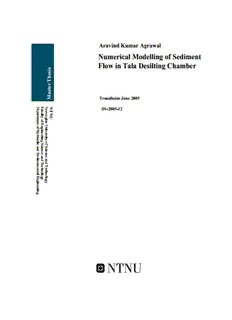
fulltext - DiVA Portal PDF
Preview fulltext - DiVA Portal
Aravind Kumar Agrawal Numerical Modelling of Sediment Flow in Tala Desilting Chamber s i s e h T r e t s a M Trondheim June 2005 DFNN D1-2005-12 epaakuorwTN rtment olty of Enegian UU f Hginniv yee draulic anering Sciersity of Sc d Environnce and Tience and mental Engin echnology Technology ee r in g FOREWORD This thesis titled ‘Numerical Modelling of Sediment Flow in Tala Desilting Chamber is submitted to the Department of Hydraulic and Environmental Engineering, NTNU, Trondheim, Norway in partial fullfillment of the required of the Master of science (M.Sc.) degree in Hydropower Development(HPD). The data required & report of physical model study of Tala desilting basin is made available by CWC. The study has been carried out at NTNU, Trondheim, Norway and has been financed by NORAD. The undesigned hereby declare that the work presented in this report is my own and any significant outside input have been duly acknowledged Aravind Kumar Agrawal Trondheim, Norway June 2005 ACKNOWLEDGEMENT I would like to thank all the individuals and organisations who have helped or provided the guidance during the course of study. Among the organisations, firstly I would like to thanks the Norwegian agency for Development and Co-operation (NORAD) who provided the opportunity to study at Norges Tekniss-Naturvitenskaplige Universitet(NTNU) under NORAD Fellowship program. I am also thankful to Central Water commission for all efforts from granting the study leave to providing all reports and drawings required for this thesis work. I don’t have words to express my thanks to Professor Nils Reider B. Olsen, in fact no words can express his generosity. He is the generator of this SSIIM programme, which has been used for this study. All through this work he has provided his guidance and help. A lot of time he has spend to reply all of my question, advice, counselling. From the inception as and whenever required, he was always ready to appease my queries. In quite simple way he made the understanding of this model easier. Also I would like to special thanks to Dr. D.V. Thareja, Chief engineer, Central Water Commission, who encouraged and made available drawings and reports needed for it. I would also thank Director I.K.Chugh, HCD(E&NE) Dte. for make available the drawing in quite short duration of time of one or two day. Help offered to make my study possible at NTNU, by senior officers like Mr. M.E. Haque, Mr. M. S. Agrawal, V.K.Talwar is unforgettable. Dr. Haakon, stole, with his experience and knowledge also facilitated. Mrs. Hilbjørg Sandvik, who is always eager to provide assistance in no times made study quite easy and comfortable and helped to finish the thesis work in time. I also express my gratitude to Nils. R. Ruther, who guided some times. I am also thankful to all officers, seniors, colleges and friends who helped one or another way to make possible this study. Due to space constraint its not possible to name all. Last but not least I would extend my word of thanks to my family, who helped me during all this duration of my study. Executive Summary This thesis is about estimation of trap efficiency of desilting basin using numerical model program named as SSIIM. SSIIM is acronym for Sediment Simulation in Intakes with Multiblock Option. It is developed by Dr. Nils Reider B. Olsen, Professor at NTNU, Norway and complete software is freely available over net with user manual. The program is a stepping stone in the field of Computational Fluid Dynamics (CFD). Study is based on desilting basin of Tala Hydropower Project (6X170 MW), an Indo Bhutan Joint venture. A physical model study of the same was done in Central Water Power Research Station (CWPRS), Pune, India,. Here this physical model and prototype both has been simulated, but with more emphasis over first one. Three dimensional flow and sediment calculation is evaluated over three dimensional grid using Power Law Scheme (POW) with no heeding towards Second order upwind scheme (SOU). The results are analysed, compared with physical model study and discussed. All the input data i.e. grid co-ordinates and different parameters used are appended in two files named koordina and control, using these program can be run. Number of different options were tried, but only few important has been discussed. Simulation result is found in harmony with physical model result. As real time data of sediment was not available for prototype, a relationship curve between particle size in prototype and model, as per CWPRS report, is used to get input sediment particle size for prototype. Location of Bhutan on world Map (Ref: http://www.mapsofworld.com) Location of Tala Hydro Electric Project in Bhutan Table of Content Annexure i List Of Figures ii List Of Tables ii List Of Abbreviation iii List Of Symbols iv List Of Reference v Salient Features vi 1 CHAPTER INTRODUCTION 1-1 1.1 INTRODUCTION 1-1 1.2 OBJECTIVE 1-2 1.3 STRUCTURE OF THE REPORT 1-2 2 CHAPTER BRIEF REVIEW OF HEAD WORKS 2-1 2.1 INTRODUCTION 2-1 2.2 INTAKES 2-1 2.2.1 SIDE INTAKE 2-1 2.2.2 FRONTAL INTAKE 2-2 2.2.3 DROP INTAKE 2-2 2.3 DESILTING BASINS 2-3 2.3.1 GENERAL 2-3 2.3.2 DESIGN PRINCIPLE 2-3 2.3.2.1 Flushing Discharge 2-3 2.3.2.2 Velocity in the Chamber Basin 2-3 2.3.2.3 Size of sediment Load to be Removed 2-4 2.3.2.4 Desilting chamber dimensions 2-4 2.3.2.5 Trap Efficiency 2-5 2.3.3 SEDIMENT REMOVAL TECHNIQUES 2-5 2.3.4 While basin is in operation 2-5 2.3.4.1 Continuous flushing 2-5 2.3.4.2 Intermittent flushing 2-6 2.3.5 While basin is out of operation 2-10 3 CHAPTER TALA HYDROELECTRIC PROJECT 3-1 3.1. INTRODUCTION 3-1 3.2. PROJECT FEATURES 3-1 3.2.1 LAYOUT 3-1 3.2.2 TOPOGRAPHY 3-1 3.2.3 HYDROLOGY 3-2 3.2.4 SEDIMENTOLOGY 3-2 3.2.5 GEOLOGY 3-2 3.2.6 ENVIRONMENT AND ECOLOGY 3-3 3.3. PROJECT HEADWORKS 3-3 3.3.1 DIVERSION ARRANGEMENTS 3-3 3.3.2 DESILTING ARRANGEMENT 3-3 3.3.3 PHYSICAL MODEL STUDIES 3-4 3.4. PROJECT FINANCE 3-4 3.5. CURRENT STATUS 3-5
Description: